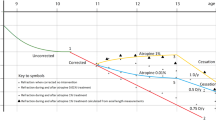Abstract
Purpose
This study seeks to demonstrate the existence of a feedback loop controlling myopia by comparing the prediction of a feedback model to the actual progression of corrected myopia. In addition to theoretical results, confirming clinical data are presented.
Methods
The refraction of 13 continuously corrected myopic eyes was collected over a period of time ranging from 4 to 9 years from the time of their first correction. Refractive data was collected in an optometry office from myopic young subjects from the general population in Boston. Subjects were myopes, ages 2 to 22 at the time of first correction selected randomly from a larger population. All individuals were fully corrected with lenses; new lenses were prescribed every time that their myopia increased by 0.25 diopters or more. Subjects wore their spectacle lenses during the followed period.
Results
Subjects exhibit a linear time course of myopia progression when corrected with lenses. The observed rate of myopia increase is 0.2 to 1.0 diopters/year, with a mean correlation coefficient r = −0.971, p < 0.005.
Conclusions
This report establishes that feedback control theory applies to the clinical phenomenon of progressive myopia. Continuous correction of myopia results in a linear progression that increases myopia. The Laplace transformation of temporal refractive data to the s-domain simplifies the study of myopia and emmetropia. The feedback transfer function predicts that continuous correction of myopia results in a linear progression because continuous correction opens the feedback loop. This prediction is confirmed with all subjects.



Similar content being viewed by others
References
Pan C, Ramamurthy D, Saw SM (2012) Worldwide prevalence and risk factors for myopia. Ophthalmic Physiol Opt 32:3–16
Medina A (1987) A model for emmetropization: predicting the progression of ametropia. Ophthalmologica 194:133–139
Medina A (1987) A model for emmetropization: The effect of corrective lenses. Acta Ophthalmol 65:565–571
Meyer C, Mueller MF, Duncker GI, Meyer HG (1999) Experimental animal models are applicable to human juvenile-onset myopia. Surv Ophthalmol 4:93–102
Medina A, Fariza E (1993) Emmetropization as a first-order feedback system. Vis Res 33(1):21–26
Zhao H, Wang R, Wu M, Jiang J (2011) Dynamic changes of ocular biometric parameters: a modified form-deprivation myopia model of young guinea pigs. Int J Ophthalmol 4:484–488
Raviola E, Wiesel TN (1985) An animal model of myopia. N Engl J Med 312(25):1609–1615
Greene PR, Guyton DL (1986) Time course of rhesus lid-suture myopia. Exp Eye Res 42:529–534
Hoyt CS, Stone RD, Fromer C, Billson FA (1981) Monocular axial myopia associated with neonatal eyelid closure in human infants. Am J Ophthalmol 9:197–200
Ray WA, O'Day DM (1985) Statistical analysis of multi-eye data in ophthalmic research. Inv Ophthalmol Vis Sci 26:1186–1188
Goss DA (1987) Linearity of refractive change in childhood myopia progression. Am J Optom Physiol Opt 64:775–780
Oakley KH, Young FA (1975) Bifocal control of myopia. Am J Optom Physiol Opt 52:738–764
Chung K, Mohidin N, O'Leary DJ (2002) Undercorrection of myopia enhances rather than inhibits myopia progression. Vision Res 42(22):2555–2559
Adler D, Millodot M (2006) The possible effect of undercorrection on myopic progression in children. Clin Exp Optom 89(5):315–321
Leung JT, Brown B (1999) Progression of myopia in Hong Kong Chinese schoolchildren is slowed by wearing progressive lenses. Optom Vis Sci 76(6):346–354
Berntsen DA, Sinnott LT, Mutti DO, Zadnik K (2012) A randomized trial using progressive addition lenses to evaluate theories of myopia progression in children with a high lag of accommodation. Inv Ophthalmol Vis Sci 53:640–649
Vasudevana B, Esposito C, Petersona C, Coronado C, Ciuffreda K (2014) Under-correction of human myopia – is it myopigenic?: a retrospective analysis of clinical refraction data. J Optom 07:147–152
Goss DA (1994) Effect of spectacle correction on the progression of myopia in children — a literature review. J Am Optom Assoc 65:117–128
Ong E, Grice K, Held R, Thorn F, Gwiazda J (1999) Effects of spectacle correction on the progression of myopia in children. Optom Vis Sci 76(6):363–369
The COMET Group (2013) Myopia stabilization and associated factors among participants in the Correction of Myopia Evaluation Trial (COMET). Invest Ophthalmol Vis Sci 54:7871–7883
Pärssinen O, Kauppinen M, Viljanen A (2014) The progression of myopia from its onset at age 8–12 to adulthood and the influence of heredity and external factors on myopic progression. A 23-year follow-up study. Acta Ophthalmol 92(8):730–739
Flitcroft DI (2014) Emmetropisation and the aetiology of refractive errors. Eye 28:169–179
Conflict of interest statement
The author certifies that he has NO affiliations with or involvement in any organization or entity with any financial interest (such as honoraria; educational grants; participation in speakers’ bureaus; membership, employment, consultancies, stock ownership, or other equity interest; and expert testimony or patent-licensing arrangements), or non-financial interest (such as personal or professional relationships, affiliations, knowledge or beliefs) in the subject matter or materials discussed in this manuscript.
Author information
Authors and Affiliations
Corresponding author
Rights and permissions
About this article
Cite this article
Medina, A. The progression of corrected myopia. Graefes Arch Clin Exp Ophthalmol 253, 1273–1277 (2015). https://doi.org/10.1007/s00417-015-2991-5
Received:
Revised:
Accepted:
Published:
Issue Date:
DOI: https://doi.org/10.1007/s00417-015-2991-5




